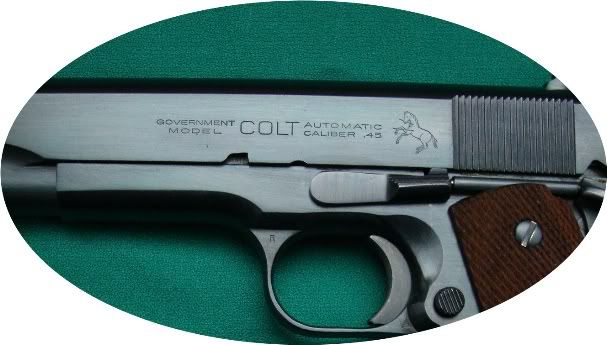I have a GI Mix Master with 1944 RR frame Arsenal stamped. The slide is a
50's era Colt Govt. Model. In a previous post I received some great info regarding the Military contracting with Colt during the Korean War to supply the Military with replacement slides
As you know Colt was making commercial Govt Mod. 1911 A1's after WWII. These slides are identifiable by the polishing process that smoothed the edges of the letters and removed the milling machine horizontal lines on the flat surfaces: also they were blued.
However, the Govt Model slides going to the military are identifiable by the features they were not polished resulting in letters with sharp edges and numerous horizontal lines across the flat surfaces, they were parkerized. From this information I now know my slide is the military model.
Also I was told this was the first "Hardened steel slide" used by the military?
My question is what is the history behind the need for Hard slides? Did the originals wear out? Were there failures in the originals? Who came up with the hard Slide?
BTW I was thinking about replacing my slide for a WWII RR to return it, as much as possible to the Original. However since I know now this slide was a military issue and could have been in Korea and in Vietnam it does have a military history (probably will keep it). This mix master looks very much like the side arms we used over in the swamps of the delta.
50's era Colt Govt. Model. In a previous post I received some great info regarding the Military contracting with Colt during the Korean War to supply the Military with replacement slides
As you know Colt was making commercial Govt Mod. 1911 A1's after WWII. These slides are identifiable by the polishing process that smoothed the edges of the letters and removed the milling machine horizontal lines on the flat surfaces: also they were blued.
However, the Govt Model slides going to the military are identifiable by the features they were not polished resulting in letters with sharp edges and numerous horizontal lines across the flat surfaces, they were parkerized. From this information I now know my slide is the military model.
Also I was told this was the first "Hardened steel slide" used by the military?
My question is what is the history behind the need for Hard slides? Did the originals wear out? Were there failures in the originals? Who came up with the hard Slide?
BTW I was thinking about replacing my slide for a WWII RR to return it, as much as possible to the Original. However since I know now this slide was a military issue and could have been in Korea and in Vietnam it does have a military history (probably will keep it). This mix master looks very much like the side arms we used over in the swamps of the delta.






